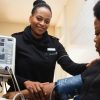According to a Commonwealth Fund Survey, more and more physicians are at risk of burnout and health systems globally are facing a primary care crisis[1] as well as staff shortages. These have been accelerated by the Covid-19 pandemic and worsened by budget cuts and an aging population suffering from more chronic ailments than ever before.
Efficiency and productivity are top priorities, especially when it comes to budget considerations, and both national and privately owned medical facilities are finding that Unified Communications (UC) can play a key role in improving both working conditions and patient outcomes.
Five Ways UC Solutions Help Health Care Professionals
Crystal-clear voice quality. In critical healthcare environments, where teams communicate across large environments, voice quality is extremely important. Clear voice is a key differentiator when it comes to getting medication administered correctly, in the right dosage and at the right time. A partial or unclear message that could lead clinicians or nurses to mishear or miss critical calls cannot be an option in such critical, fast-paced environments.
Better time-management. During a normal 12-hour shift nurses walk an average of five miles between visiting the pharmacy, checking doses and updating clinical records. Introducing enterprise mobility solutions within a UC environment can therefore have a positive and tangible impact on clinicians, as they are able to spend less time rushing back to their desk to input information on a laptop or desktop PC, instead increasing the time they spend making their rounds and tending to patients. In addition, enterprise UC solutions allow busy nurses to call up drugs from the pharmacy without leaving the patient bedside, and to log treatment times and dosages on their portable devices from wherever they are.
Ensuring patient privacy. To protect sensitive patient data, some hospitals do not allow medical staff to take personal mobile devices into restricted areas (e.g., wards or pharmacies). Enterprise devices that can be put into “lockdown” mode while not in use allow HCPs to carry their devices with them throughout their shifts. In addition, UC devices—thanks to automated adherence to mandatory clinical workflows and interoperability with leading communication and collaboration platforms—allow staff to confirm medication, and update and share clinical information and electronic health records (EHRs) without leaving the patient’s bedside.
Supporting Staff Safety. Unfortunately assaults on healthcare staff are far too common and disappointingly on the rise[2], with a staggering 90% of emergency care staff reporting they have experienced physical violence[3]. Ensuring HCPs are continuously connected, with handsets that incorporate easy to action, handsfree alarms or motion sensors that issue alerts in case of an unexpected sharp fall followed by inactivity, means that medical staff can carry out their work safely. These tools may even be critical for psychiatric nurses and night shift staff.
Enhancing Patient Safety. Sensor-activated alarms can also be instrumental in improving patient safety and well-being, thanks to systems that alert medical staff and carers when a patient has fallen or is unexpectedly moving about. Once alerted, medical staff can intervene immediately whenever help or assistance is needed. One of the most interesting potential applications of this technology is its use in care homes, to allow dementia patients to enjoy more freedom of movement, without overburdening time-poor carers who are still able to monitor them and intervene when the patient is mobile or in danger. In addition, most enterprise-grade UC devices are compatible with fire alarm systems, increasing everyone’s safety and ensuring a quicker response in case of fire.
Shortcomings of Consumer-Grade Devices
With devices often being shared in fast-paced healthcare environments, the risk of handsets coming into contact with biological waste is high, and there’s often little to no time to stop for a full recharge. It is therefore critical to ensure HCPs are provided with long-lasting, spill-resistant devices that support hot battery swaps and are designed to be sterilized effectively, daily and with hospital-grade solvent without being compromised.
Because these devices are carried around in a complex and busy environment, consumer grade handsets cannot be taken into consideration as they do not provide a suitable range of solutions for seamless collaboration. Enterprise-grade devices ensure clear reception even outside healthcare facilities, as well as compatibility with most operating systems, MDM solutions, healthcare platforms and software already in use. Central device management that is available with enterprise devices is also a plus, as it enables remote troubleshooting and device monitoring, reducing the risk of HCPs missing calls, or losing connection, important files or patient data.
Guaranteeing that HCPs are always connected is an important part of any successful patient experience strategy, as healthcare staff can spend more time with their patients. Introducing a strategic enterprise-grade UC system means medical staff can do their best work without worrying about rushing to desktops to fill out or retrieve information or having to make multiple calls to ensure they have received the right information concerning treatment or dosage. This improves not only operational effectiveness and workers well-being, but also patient outcomes and experience.
References:
[1] Commonwealth Fund, “Stressed Out and Burned Out: The Global Primary Care Crisis”
[2]TribLive, Violence in health care: Medical workers increasingly must contend with threats, assaults, 15th January 2023, https://triblive.com/local/regional/violence-in-health-care-medical-workers-increasingly-must-content-with-threats-assaults/
[3]Patient-related violence against nursing staff working in the Emergency Department: a systematic review ,JBI Library of Systematic Reviews 9(48):p 1-22, https://journals.lww.com/jbisrir/fulltext/2011/09481/patient_related_violence_against_nursing_staff.6.aspx







